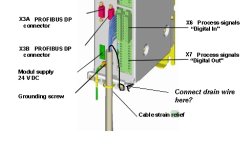Hello to all,
i'm reading the manual regarding this module from Siemens, and since English is not my native language I'm not sure if I understand this text correctly:
Clamping the cable shielding
The shielding of cables carrying analog signals and of PROFIBUS DP cables
should be clamped and grounded upstream of
the terminals on the module. If the
cables are not grounded until further downstream at the strain relief, any high-
energy interference from the shielding will be discharged across the module
enclosure, and thus impair the module’s resistance to interference.
I wonder how to process correctly. I use copper solid wire cable like this one. This cable has alu foil and drain wire that needs to be grounded on only one side of the cable.
Now since the analog input and output signals will be transmitted via this cable, I wonder should I ground this drain wire on the module side or on the other side of the cable (in local junction box)?
Not really sure what this "upstream" and "downstream" means.
Normally in my previous experience cables with analog signals from the field were grounded in the PLC cabinet very near the PLC input card.
Can you please help me understand this part of the manual? If I understood this correctly, I need to ground this drain wire near the connector terminals on the module and not to go further (outside) the module.
Thank you
i'm reading the manual regarding this module from Siemens, and since English is not my native language I'm not sure if I understand this text correctly:
Clamping the cable shielding
The shielding of cables carrying analog signals and of PROFIBUS DP cables
should be clamped and grounded upstream of
the terminals on the module. If the
cables are not grounded until further downstream at the strain relief, any high-
energy interference from the shielding will be discharged across the module
enclosure, and thus impair the module’s resistance to interference.
I wonder how to process correctly. I use copper solid wire cable like this one. This cable has alu foil and drain wire that needs to be grounded on only one side of the cable.
Now since the analog input and output signals will be transmitted via this cable, I wonder should I ground this drain wire on the module side or on the other side of the cable (in local junction box)?
Not really sure what this "upstream" and "downstream" means.
Normally in my previous experience cables with analog signals from the field were grounded in the PLC cabinet very near the PLC input card.
Can you please help me understand this part of the manual? If I understood this correctly, I need to ground this drain wire near the connector terminals on the module and not to go further (outside) the module.
Thank you
Last edited:





